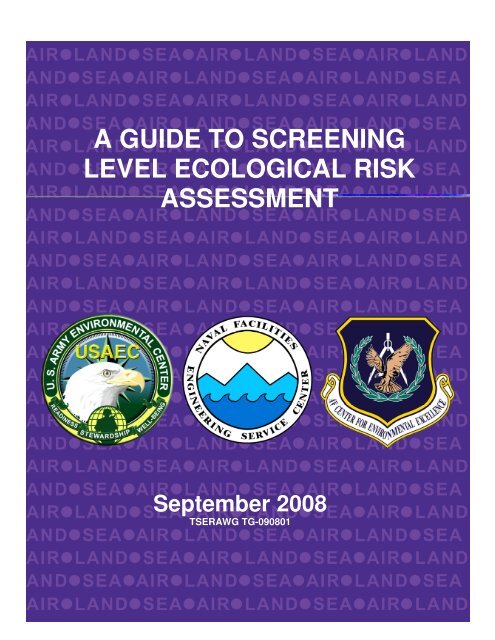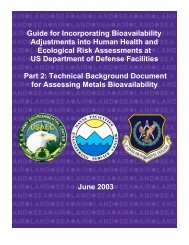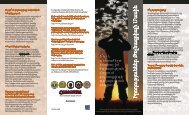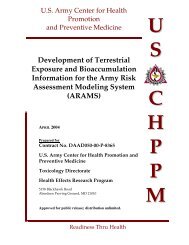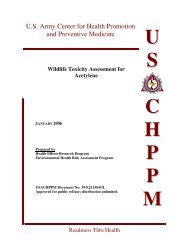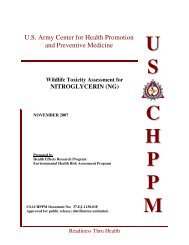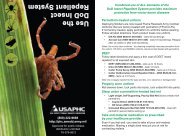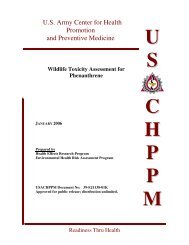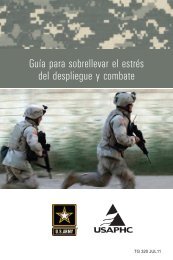a guide to screening level ecological risk assessment - U.S. Army ...
a guide to screening level ecological risk assessment - U.S. Army ...
a guide to screening level ecological risk assessment - U.S. Army ...
You also want an ePaper? Increase the reach of your titles
YUMPU automatically turns print PDFs into web optimized ePapers that Google loves.
A GUIDE TO SCREENING<br />
LEVEL ECOLOGICAL RISK<br />
ASSESSMENT<br />
September 2008<br />
TSERAWG TG-090801
TSERAWG TG-090801<br />
$"%&' & ( (& &)$ &*"<br />
!" ! #<br />
A Note <strong>to</strong> readers:<br />
Consensus following a peer review of <strong>risk</strong> <strong>assessment</strong>s at several U.S. military installations<br />
revealed significant inconsistencies in approach <strong>to</strong> <strong>ecological</strong> <strong>risk</strong> <strong>assessment</strong>s. Therefore, a<br />
need was identified <strong>to</strong> provide more specific information for the scoping and development of<br />
<strong>screening</strong> <strong>level</strong> <strong>ecological</strong> <strong>risk</strong> <strong>assessment</strong>s. This document is intended <strong>to</strong> serve as guidance <strong>to</strong><br />
those involved in scoping, planning and conducting <strong>ecological</strong> <strong>risk</strong> <strong>assessment</strong>s at U.S. military<br />
installations. This document was written, developed, and reviewed consistent with applicable<br />
military regulations (e.g. AR 200-1), policy (e.g. US Navy 1999), and U.S. Environmental<br />
Protection Agency guidance.<br />
This document was initially developed through the U.S. <strong>Army</strong> Biological Technical Assistance<br />
Group (BTAG). This document was subsequently reviewed and found consistent with the <strong>risk</strong><br />
<strong>assessment</strong> procedures and guidance of the Navy and Air Force through the Tri-Services<br />
Environmental Risk Assessment Work Group (TSERAWG). The authors of this document are<br />
Mr. Andrew Rak, USACE Baltimore District, Ms. Mary Ellen Maly, USAEC, and Dr. Greg<br />
Tracey, SAIC. Technical reviewers are Mr. Terry Walker, USACE HTRW-CX, Dr. Brandolyn<br />
Thran, USACHPPM, Ms. Laurie Haines, USAEC, and Dr. Mark S. Johnson (USACHPPM).<br />
ii
Table of Contents<br />
1.0 Introduction ............................................................................................................................. 1<br />
1.1 Overview of Screening-Level Ecological Risk Assessment ....................................... 1<br />
1.2 Available Background Documents ............................................................................ 2<br />
2.0 Planning for the SLERA ......................................................................................................... 2<br />
2.1 Managing the Ecological Risk Assessment ............................................................... 3<br />
2.1.1 Statements of Work....................................................................................... 3<br />
2.1.2 Independent Government Cost Estimates .................................................... 3<br />
2.1.3 Contract Vehicles.......................................................................................... 4<br />
2.1.4 Timelines and Schedules............................................................................... 4<br />
2.2 Screening-Level Prolem Formulation....................................................................... 4<br />
2.3 Environmental Setting and Contaminants Characterization..................................... 7<br />
2.4 Fate and Transport .................................................................................................... 7<br />
3.0 Screening-Level Exposure Estimate and Risk Calculation .................................................... 8<br />
3.1 Categories of Recep<strong>to</strong>rs ............................................................................................... 8<br />
3.2 Complete Exposure Pathways...................................................................................... 9<br />
3.3 Assessment and Measurement Endpoints.................................................................. 10<br />
3.4 Exposure Parameters.................................................................................................. 10<br />
3.5 Assembling / Developing Toxicity Benchmarks ....................................................... 13<br />
3.5.1 Preferred Toxicity Data............................................................................... 13<br />
4.0 Risk Characterization: Screening-Level Risk Calculation .................................................... 14<br />
5.0 Scientific/Management Decision Point (SMDP)................................................................... 15<br />
6.0 Refinement of the SLERA………………………………………………………… ………17<br />
7.0 Uncertainty Assessment......................................................................................................... 17<br />
8.0 Summary................................................................................................................................ 18<br />
9.0 References.............................................................................................................................. 20<br />
iii
$&( * + "&" % , % +*%* &+ % & -<br />
' "<br />
1.0 Introduction.<br />
This document was prepared <strong>to</strong> aid remedial project managers (RPMs) in understanding and<br />
executing <strong>screening</strong>-<strong>level</strong> <strong>ecological</strong> <strong>risk</strong> <strong>assessment</strong>s (SLERAs) at hazardous waste sites. The<br />
SLERA process described here is consistent with the USEPA’s Ecological Risk Assessment<br />
Guidance for Superfund (ERAGS): Process for Designing and Conducting Ecological Risk<br />
Assessments (USEPA 1997), written for application within the Comprehensive Environmental<br />
Response, Compensation, and Liability Act (CERCLA) program. ERAGS is appropriate for<br />
Installation Res<strong>to</strong>ration Program (IRP) sites, Base Realignment and Closure (BRAC) sites, and<br />
Formerly Used Defense Sites (FUDS), and may also be applied <strong>to</strong> corrective action sites<br />
investigated under the Resource Conservation and Recovery Act (RCRA); hereafter referred <strong>to</strong><br />
as “sites”.<br />
While there is guidance available regarding the general <strong>ecological</strong> <strong>risk</strong> <strong>assessment</strong> (ERA)<br />
process (Wentsel et al. 1994, USEPA 1997, 1998), little specific guidance for preparation of a<br />
SLERA is available. Therefore, the purpose of this document is <strong>to</strong> present an overview as <strong>to</strong><br />
how <strong>to</strong> prepare a SLERA in a manner that is both understandable <strong>to</strong> the DoD RPM and useful for<br />
facilitating <strong>risk</strong> communication between the Services, the regula<strong>to</strong>ry community, and the public.<br />
1.1 Overview of Screening-Level Ecological Risk Assessment.<br />
The ERA process is used <strong>to</strong> evaluate potential hazards <strong>to</strong> the environment that are attributable <strong>to</strong><br />
chemical releases from site-related activities. The process is generally divided in<strong>to</strong> two tiers, the<br />
SLERA and the Baseline ERA (BERA).<br />
The USEPA (1997) defines the SLERA process as follows:<br />
“A simplified <strong>risk</strong> <strong>assessment</strong> that can be conducted with limited data; where site-specific<br />
information is lacking, assumed values should consistently be biased in the direction of<br />
overestimating <strong>risk</strong>… The need for conservatism is <strong>to</strong> provide a defensible conclusion that<br />
negligible <strong>ecological</strong> <strong>risk</strong> exists or that certain contaminants and exposure pathways can be<br />
eliminated from consideration”.<br />
The SLERA is generally meant <strong>to</strong> be a simple desk<strong>to</strong>p analysis <strong>to</strong> eliminate substances or even<br />
sites from further consideration. This occurs through a relatively cost/time efficient effort that<br />
requires very limited data from the site and relies heavily on other (e.g., literature) information.<br />
Since by definition the SLERA is designed <strong>to</strong> be cost and time efficient, using limited site data,<br />
assumptions and parameters used in the exposure models are heavily biased <strong>to</strong> reduce the<br />
probability of incorrectly eliminating substances from further consideration.<br />
1
Often the only site data that are used in the SLERA are media-specific chemical concentrations.<br />
The amount of data available for the SLERA depends on the degree of site characterization and<br />
the type of data that has been collected. The SLERA is designed for implementation at the initial<br />
stages of investigation, typically during the Site Inspection (SI).<br />
The SLERA may help eliminate pathways of exposure (e.g., soil ingestion), foraging guilds (e.g.<br />
small mammalian herbivores), and even entire sites (yet in practice this is rare given the biased<br />
approach that is used). Since organisms of concern (i.e., Assessment Endpoints) have not yet<br />
been defined, and since a biased <strong>screening</strong>-<strong>level</strong> approach is used <strong>to</strong> estimate exposure, remedial<br />
decisions should not be made based upon the outcome of the SLERA. The SLERA’s most<br />
valuable function is <strong>to</strong> refine the larger list of substances in<strong>to</strong> a more defined list of Chemicals of<br />
Potential Ecological Concern (COPECs). The SLERA can also help define which recep<strong>to</strong>rs and<br />
pathways <strong>to</strong> those recep<strong>to</strong>rs that will be evaluated in the BERA, and function <strong>to</strong> rank the relative<br />
importance of specific substances.<br />
1.2 Available Background Documents.<br />
The foundation for the present ERA approach was presented in the Framework for Ecological<br />
Risk Assessment (USEPA 1992a), which was superseded by the Guidelines for Ecological Risk<br />
Assessment (USEPA 1998). The most recent procedural guidance is contained in ERAGS<br />
(USEPA 1997). ERAGS prescribes an 8-step process, the first two steps constituting the<br />
SLERA. The reader is also directed <strong>to</strong> The Role of Screening-Level Risk Assessments and<br />
Refining Contaminants of Concern in Baseline Ecological Risk Assessments (USEPA 2001b) for<br />
additional discussion on how the SLERA is applied in the CERCLA process.<br />
The Department of Defense (DoD) Tri-Services Ecological Risk Assessment Work Group has<br />
also produced ERA guidance generally following ERAGS pro<strong>to</strong>cols. The Tri-Service<br />
Procedural Guidelines for Ecological Risk Assessments (Wentsel et al. 1996) preceded ERAGS<br />
but advocated the same 8-step process. The Tri-Service Remedial Project Manager’s Technical<br />
Handbook for Ecological Risk Assessment (Simini et al. 2000) provides the RPM with<br />
information <strong>to</strong> ensure the ERA stays focused while being timely and cost-effective.<br />
The guidance documents cited above generally focus on the preparation and implementation of<br />
the BERA while qualified detailed guidance for conduct of the SLERA is generally lacking.<br />
2.0 Planning for the SLERA.<br />
The <strong>Army</strong> BTAG has prepared a technical document specifically for planning an ERA (USA<br />
BTAG 2002a). This document applies the U.S. <strong>Army</strong> Corps of Engineers (USACE) Technical<br />
Project Planning (TPP) guidance (USACE 1998). The TPP process assists in establishing the<br />
focus of the <strong>risk</strong> <strong>assessment</strong> and in determining data needs. The process also stresses early<br />
engagement of all stakeholders. Additional information relative <strong>to</strong> planning and stakeholder<br />
involvement throughout the entire ERA process is discussed in the Presidential/Congressional<br />
Commission’s report on <strong>risk</strong> <strong>assessment</strong> and <strong>risk</strong> management (PCRARM 1997).<br />
2
Site-specific technical assistance with planning for a SLERA can be obtained through the U.S.<br />
<strong>Army</strong> Center for Health Promotion and Preventive Medicine (USACHPPM)(http://chppmwww.apgea.army.mil/),<br />
the USACE Environmental and Munitions Center of Expertise (EM CX)<br />
(http://www.environmental.usace.army.mil/) and/or the <strong>Army</strong> BTAG<br />
(http://aec.army.mil/usaec/cleanup/btag00.html).<br />
2.1 Managing the Ecological Risk Assessment<br />
At most military sites, the ERA will be performed by a contrac<strong>to</strong>r either directly for the<br />
installation or through an executing agency. In this case, the role of the RPM at the installation<br />
will be <strong>to</strong> provide direction <strong>to</strong> and oversight of the contrac<strong>to</strong>r, usually with the assistance of a<br />
technical support staff. This section of the report provides details on the items that an<br />
installation-<strong>level</strong> or service center RPM may need <strong>to</strong> complete or review <strong>to</strong> ensure that the<br />
SLERA will meet the needs of the installation’s environmental res<strong>to</strong>ration program.<br />
2.1.1 Statements of Work<br />
There are two existing guidance documents for writing a statement of work (SOW) for an ERA<br />
(USEPA 1992d, USACE 2002). Both documents emphasize a phased approach <strong>to</strong> the<br />
implementation of the ERA.<br />
For most sites, a phased approach with expert review at each phase results in the most efficient<br />
use of resources. With the phased data approach, evaluation of data from one phase determines<br />
whether further information is needed <strong>to</strong> meet the <strong>assessment</strong>’s objectives. At some sites, the<br />
phased approach might result in a low <strong>level</strong> of effort adequately characterizing <strong>ecological</strong> <strong>risk</strong>s.<br />
At others, the phased approach might indicate that the <strong>assessment</strong> should be expanded <strong>to</strong> include<br />
studies of specific habitats or contaminants in order <strong>to</strong> evaluate the <strong>risk</strong>s. At still other sites, the<br />
phased approach could identify areas originally not considered at <strong>risk</strong>. In this case, the DoD<br />
RPM would want <strong>to</strong> expand the work scope <strong>to</strong> include an <strong>assessment</strong> of the newly identified<br />
area. Review of interim products, such as a report on the <strong>level</strong>s of contaminants of concern or a<br />
field survey of resident species, can contribute <strong>to</strong> the phased approach. Careful review of interim<br />
products can help <strong>to</strong> ensure that the <strong>assessment</strong> remains focused on those projects most important<br />
for evaluating the site’s <strong>ecological</strong> effects.<br />
Additionally other mechanisms that are performance-based may be applicable particularly in this<br />
application (e.g. performance-based contracting). However, scopes of work must be specific in<br />
regards <strong>to</strong> end product.<br />
2.1.2 Independent Government Cost Estimates<br />
An independent government estimate (IGE) of the cost of the SLERA is required as part of the<br />
contracting process, if the <strong>to</strong>tal cost of the SLERA is expected <strong>to</strong> exceed $25K. Most SLERAs<br />
3
will cost more than this threshold and therefore an IGE is almost always necessary. The <strong>level</strong> of<br />
detail for the IGE is dependent on the type of the contract vehicle and the requirements of the<br />
contracting officer. The <strong>to</strong>tal cost for the SLERA is directly proportional <strong>to</strong> the amount of data<br />
available for review and assimilation. The tasks in the IGE should be based on those listed in the<br />
SOW. A SLERA for a simple <strong>to</strong> moderately complex site should require between 200 <strong>to</strong> 500<br />
hours depending on the data collection needs and the amount of available data, plus project<br />
management and any sampling/analysis requirements. More information can be found at the<br />
Federal Acquisition Regulation, Part 37, Subpart 37.6<br />
(http://farsite.hill.af.mil/reghtml/regs/far2afmcfars/fardfars/far/37.htm).<br />
2.1.3 Contract Vehicles<br />
There are three main types of contract vehicles that seem appropriate for the SLERA, time and<br />
materials, firm-fixed price, and cost plus. The SLERA may be one of many deliver orders issued<br />
under a given particular contract vehicle. The type of the contract vehicle may be selected by the<br />
installation, USACE District, or other contracting center.<br />
Because of the defined nature of the SLERA, the firm-fixed price type of contract is the most<br />
appropriate for simple <strong>to</strong> moderately complex sites. For sites that are very complex due <strong>to</strong> the<br />
nature of the contamination, number of recep<strong>to</strong>rs, or because of the presence of multiple<br />
threatened and endangered species, a time and materials or cost-plus contract vehicle may be<br />
more appropriate.<br />
2.1.4 Timelines and Schedules<br />
From start <strong>to</strong> finish the SLERA should require 12-18 months, including time for internal and<br />
external review, meetings, site visits, and reporting writing. From the date of award of the<br />
contract or delivery order, a SLERA draft work plan should be available in 30-60 days<br />
depending on the amount of existing data that has <strong>to</strong> be reviewed and assimilated. Site-specific<br />
climatic conditions (e.g., extensive snow cover) would likely limit data collection efforts and<br />
should be considered when building the SLERA schedule.<br />
During the SLERA it may be necessary <strong>to</strong> collect additional samples <strong>to</strong> better characterize<br />
locations and media not fully addressed in existing reports (e.g., PA or SI reports). Timelines<br />
and schedules should be extended if additional data are required <strong>to</strong> complete the SLERA.<br />
Schedule and deliverables should be adjusted <strong>to</strong> accommodate field mobilization, sample<br />
collection, and sample analysis. Additional data would usually include collection and analysis of<br />
water, soil or sediment samples. Additional data would not typically include <strong>to</strong>xicity tests,<br />
tissue/organ collection, biomoni<strong>to</strong>ring, or similar intensive <strong>ecological</strong> field studies.<br />
2.2 Screening-Level Problem Formulation and Ecological Effects Evaluation.<br />
In the SLERA, it is important <strong>to</strong> recognize the following relationship:<br />
4
Risk = Exposure/Toxicity<br />
Here an estimate of exposure is compared with a <strong>to</strong>xicity benchmark that represents the upper<br />
<strong>level</strong> of what is considered acceptable. Both can be either chemical-specific media<br />
concentrations (e.g., mg substance/kg soil) or oral dose estimates (in mg substance/kg body/day).<br />
Both must be in the same units, however. Where there is no exposure, there is no <strong>risk</strong>.<br />
Problem formulation and <strong>ecological</strong> effects evaluation for the SLERA is Step 1 of the ERAGS<br />
process (USEPA 1997). The purpose of this step is <strong>to</strong> gather existing data about the site and<br />
associated chemicals <strong>to</strong> identify how those chemicals might impact organisms within the<br />
ecosystem. USEPA guidance recommends establishing a "picture" of the site <strong>to</strong> assist in<br />
problem formulation. This picture becomes the conceptual site model (CSM). The CSM can<br />
have multiple forms. Figure 1 is an example CSM based on ASTM Standard E1689-95 (ASTM<br />
1995). In the <strong>screening</strong>-<strong>level</strong> problem formulation, a CSM is developed <strong>to</strong> address the<br />
environmental setting and contaminants characterization, fate and transport, routes of exposure<br />
and categories of recep<strong>to</strong>rs, complete exposure pathways, and endpoints <strong>to</strong> evaluate for the<br />
potential for adverse effects. In development of the CSM, the following questions are addressed:<br />
• Do transport pathways exist at the site that could result in <strong>to</strong>xic exposures <strong>to</strong> terrestrial or<br />
aquatic recep<strong>to</strong>rs?<br />
• Do exposure pathways exist where recep<strong>to</strong>rs are in direct contact with the contaminated<br />
media?<br />
• Do transport pathways exist at the site wherein the consumption of prey containing elevated<br />
body burdens results in chemical exposure at <strong>level</strong>s that can cause harm <strong>to</strong> preda<strong>to</strong>rs?<br />
For wildlife, oral exposures are predominantly considered. Because of data limitations,<br />
exposures <strong>to</strong> substances via inhalation or dermal exposures are not quantified, but should be<br />
addressed in the uncertainty <strong>assessment</strong> section of the SLERA.<br />
5
Fig. 1 Example Site Conceptual Model (CSM; ASTM 1995).<br />
6
2.3 Environmental Setting and Contaminants Characterization.<br />
The description of the site environmental setting is important <strong>to</strong> the problem formulation because<br />
it determines the habitats where biota might be located as well as the chemicals <strong>to</strong> which they<br />
could be exposed. The first step is <strong>to</strong> compile the his<strong>to</strong>rical information for the site. The second<br />
step is <strong>to</strong> use the environmental checklist (Appendix A, USEPA 1997) during a site visit. The<br />
checklist will <strong>guide</strong> the <strong>risk</strong> assessor in evaluation of on- and off-site habitats, land uses and<br />
migration pathways.<br />
Habitats are generally divided in<strong>to</strong> two major groups (terrestrial and aquatic) and subdivided<br />
based on their biotic and abiotic characteristics. The following sources may be useful when<br />
examining the available habitat:<br />
• The installation’s Integrated Natural Resources Management Plan (INRMP)<br />
• USGS Land Use Land Cover and Topographic maps (http://eros.usgs.gov/)<br />
• Geo-referenced aerial pho<strong>to</strong>graphs<br />
• Natural Resources Conservation Service / USDA-ARS<br />
• Detailed maps, imagery, and data resources: http://www.nrcs.usda.gov/technical/maps.html<br />
• Site visits<br />
The most common source of information regarding the contaminants at the site is the Preliminary<br />
Assessment (PA)/Site Investigation (SI) report. The concentrations of chemicals at various<br />
locations (both vertical and horizontal) should be examined. However, since PA/SIs often have<br />
few samples biased <strong>to</strong> areas of suspect contamination, nature and extent of contamination may<br />
need <strong>to</strong> further be characterized.<br />
2.4 Fate and Transport.<br />
Physical, geological, chemical, and even biological processes control contaminant fate and<br />
transport of site contaminants. The description of contaminant fate and transport in context with<br />
the environmental setting is needed in problem formulation <strong>to</strong> define the pathways for migration<br />
of potentially hazardous substances within the media and habitat types at the site. Consideration<br />
of local-scale environmental conditions and contaminant sources is also recommended. At a<br />
local scale, physical processes include gravity-driven chemical transport determined by site<br />
<strong>to</strong>pography, including hills, ridges, culverts, berms, or any other feature that might affect the<br />
flow of water on<strong>to</strong>/in<strong>to</strong> the ground or along the surface (sheet flow). The <strong>to</strong>pography of the site<br />
should be evaluated <strong>to</strong> examine erosion patterns and channelized flow from streams. The<br />
SLERA should address preferential flow pathways that could affect off-site contamination<br />
gradients.<br />
Media-specific sample collection should also consider temporal considerations of habitat quality<br />
(e.g., data collected during wet season may be more <strong>ecological</strong>ly relevant given the importance<br />
of vernal pools in the life cycle and food resources of aquatic and wildlife species, respectively).<br />
7
This completes Step 1 of the ERAGS process. The <strong>risk</strong> assessor should evaluate the CSM <strong>to</strong><br />
determine if additional data is needed <strong>to</strong> complete the SLERA. The <strong>screening</strong>-<strong>level</strong> problem<br />
formulation summary should be included in a SLERA work plan. This can help facilitate review<br />
and approval by regula<strong>to</strong>ry agencies and other stakeholders. Data needs should be identified<br />
along with Data Quality Objectives for those data.<br />
3.0 Screening-Level Exposure Estimate and Risk Calculation.<br />
The second step of the ERAGS process is the <strong>screening</strong>-<strong>level</strong> exposure estimate and <strong>risk</strong><br />
calculation. In this step, potential site <strong>risk</strong>s are estimated by comparing maximum exposure<br />
concentrations with the eco<strong>to</strong>xicological benchmark values. The SLERA process will conclude<br />
with the scientific/management decision point (SMDP) at which it will be determined that: 1)<br />
<strong>ecological</strong> threats are negligible; 2) the process should continue <strong>to</strong> determine if a <strong>risk</strong> actually<br />
exists; or 3) a potential for adverse effects exists and a site-specific BERA is needed. In the<br />
sections below, details of the various components of exposure and the <strong>risk</strong> calculation processes<br />
are provided. Subsequently, the <strong>risk</strong> communication step discusses the overall confidence in the<br />
potential for <strong>risk</strong> (i.e., across relevant pathways and COPEC classes) as input in<strong>to</strong> the SMDP.<br />
3.1 Categories of Recep<strong>to</strong>rs.<br />
In order <strong>to</strong> screen out COPECs it is important <strong>to</strong> demonstrate that all potentially exposed<br />
organisms have been evaluated. For this reason, recep<strong>to</strong>r species that demonstrate high exposure<br />
tendencies are used <strong>to</strong> model exposure and <strong>to</strong> represent specific foraging guilds (Table 1). This<br />
is done so that it can be shown with confidence that other species, likely less exposed, are at less<br />
<strong>risk</strong> than the modeled species. Species that represent foraging guilds for <strong>risk</strong> <strong>assessment</strong> are<br />
often selected based on the extent of their exposure <strong>to</strong> soil or sediment, since these media often<br />
serve as the primary reservoir of chemical contamination at the site. A balance between<br />
choosing a recep<strong>to</strong>r from which much information is known (important in accurately<br />
characterizing exposure) and most exposed (<strong>to</strong> be protective of other species within the guild) is<br />
important. Some recep<strong>to</strong>rs/foraging guilds may be represented at the site, but <strong>to</strong>o poorly<br />
represented in the literature <strong>to</strong> allow for a quantitative estimate of <strong>risk</strong>.<br />
Recep<strong>to</strong>rs selected should represent generic foraging guilds that are <strong>ecological</strong>ly important at the<br />
site. Example foraging guilds include “small mammalian omnivore, large mammalian herbivore,<br />
and small avian invertivore” (see Table 1).<br />
For terrestrial environments, the representative recep<strong>to</strong>r groups typically include plants, soil<br />
invertebrates (e.g., worms and insects), small mammals, and birds that consume insects and<br />
plants, or other larger mammal grazers (e.g., deer) and preda<strong>to</strong>r species that utilize other small<br />
mammals, birds, amphibian, reptiles or fish as their primary food source. Potential <strong>risk</strong> <strong>to</strong><br />
amphibians and reptiles is usually relegated <strong>to</strong> the BERA since <strong>to</strong>xicity and exposure<br />
information for these organisms is lacking for most substances.<br />
Table 1. Example mammalian and avian foraging guilds and representative recep<strong>to</strong>rs.<br />
8
Foraging Guild Recep<strong>to</strong>r species Genus Species<br />
Small mammalian herbivore Meadow vole Microtus pennsylvanicus<br />
Medium mammalian herbivore Woodchuck Marmota monax<br />
Large mammalian herbivore White-tailed deer Odocoileus virginianus<br />
Small mammalian omnivore Deer mouse<br />
Peromyscus maniculatus<br />
White-footed mouse<br />
leucopus<br />
Medium mammalian omnivore Raccoon Procyon lo<strong>to</strong>r<br />
Large mammalian omnivore Coyote Canis latrans<br />
Small mammalian carnivore Short-tailed shrew Blarina brevicauda<br />
Medium mammalian carnivore Long-tailed weasel Mustela frenata<br />
Large mammalian carnivore Mountain lion Felis concolor<br />
Small avian granivore American Goldfinch Carduelis tristis<br />
Medium avian granivore Mourning Dove Zenaida macroura<br />
Small avian invertivore Ruby-crowned Kinglet Regulus calendula<br />
Medium avian omnivore American Robin Turdus migra<strong>to</strong>rius<br />
Large avian carnivore Red-tailed Hawk Buteo jamaicensis<br />
For aquatic environments, the representative recep<strong>to</strong>r groups typically include animals that might<br />
occupy streams, ponds, or marshes. These aquatic biota may include aquatic insects and worms<br />
that live in the sediment; freshwater bivalves (e.g., clams) that feed at the sediment surface;<br />
organisms that consume aquatic insects and/or bivalves; large fish that feed upon smaller fish; or<br />
semi-aquatic mammals/avian preda<strong>to</strong>rs that consume other aquatic organisms.<br />
3.2 Complete Exposure Pathways.<br />
The SLERA should focus on complete exposure pathways <strong>to</strong> the identified recep<strong>to</strong>rs. For an<br />
exposure pathway <strong>to</strong> be complete, recep<strong>to</strong>rs must be exposed (via inhalation, ingestion or dermal<br />
uptake) <strong>to</strong> a COPEC. Identifying complete exposure pathways prior <strong>to</strong> a quantitative evaluation<br />
of <strong>to</strong>xicity allows the <strong>assessment</strong> <strong>to</strong> focus on only those contaminants that have a completed<br />
pathway of exposure. Risks from oral exposures (i.e. ingestion) <strong>to</strong> hazardous substances have<br />
been the focus of most SLERAs and are generally suspected <strong>to</strong> contribute the most <strong>to</strong> <strong>risk</strong>.<br />
Moreover, data <strong>to</strong> quantify and understand the potential <strong>risk</strong>s <strong>to</strong> wildlife from dermal and<br />
inhalation exposures are generally not sufficient <strong>to</strong> provide meaningful or defensible quantitative<br />
estimates of <strong>risk</strong>.<br />
The process of determining which exposure pathways may be complete in the future is often<br />
problematic and is usually dependent on future land use options. For example, soil under a<br />
building may not be available for contact now, but may be available if the building was removed.<br />
The RPM should comply with the DOD Land Use Policy (USDOD 2001) and the installation’s<br />
master plan when applicable. The USEPA also has a formal land use <strong>assessment</strong> process<br />
(USEPA 2001a) that should also be considered.<br />
9
3.3 Assessment and Measurement Endpoints.<br />
For the SLERA, <strong>assessment</strong> endpoints (what trustees are interested in conserving) and<br />
measurement endpoints (what are used <strong>to</strong> infer on the <strong>assessment</strong> endpoints) are not developed<br />
until after the SMDP following the outcome of the SLERA (USEPA 1997). However, some<br />
consideration of habitats or species <strong>to</strong> be valued at the site that have the potential <strong>to</strong> be<br />
<strong>assessment</strong> endpoints can use the same modeled species profiles in the BERA (USA BTAG<br />
2002b). A well-planned SLERA can use some of the same modeled species in the BERA if the<br />
modeled species are later identified as measurement endpoint species. This allows for a<br />
refinement of exposure and <strong>to</strong>xicity criteria that are site-specific <strong>to</strong> refine <strong>risk</strong> estimates in the<br />
BERA.<br />
3.4 Exposure Parameters.<br />
Since oral dose estimates involve modeling feeding events and chemical concentration in media<br />
and food items, other fac<strong>to</strong>rs such as contact frequency (e.g., area use), food ingestion rates,<br />
amount of soil incidentally ingested, and bioavailability of chemical that is assimilated through<br />
the ingested item (e.g., soil or food) should be considered. In order <strong>to</strong> maintain the conservative<br />
nature of the SLERA, the highest reasonable exposure fac<strong>to</strong>rs are used. ERAGS lists the following<br />
fac<strong>to</strong>rs and provides explanation relative <strong>to</strong> how these parameters are evaluated in the SLERA and<br />
the BERA:<br />
• Area use fac<strong>to</strong>r – 100%;<br />
• Bioavailability – 100%;<br />
• Life stage of recep<strong>to</strong>r – most sensitive;<br />
• Body weight and food ingestion rate – minimum body weight <strong>to</strong> maximum ingestion rate;<br />
• Dietary composition – 100% of diet consists of the most contaminated dietary component.<br />
The Wildlife Exposure Fac<strong>to</strong>rs Handbook (USEPA 1993) presents profiles for selected species of birds<br />
and mammals. Each species profile provides a series of tables presenting values for developing fac<strong>to</strong>rs<br />
important in estimating exposure such as intake fac<strong>to</strong>rs, body weight, dietary composition, population<br />
dynamics, and seasonal activity patterns. Additional information can be found in the published literature<br />
including the ORNL A Guide <strong>to</strong> the ORNL Eco<strong>to</strong>xicological Screening Benchmarks: Background,<br />
Development, and Application. (ORNL. 1998). This information and exposure profiles for additional<br />
species have been compiled in a single volume (Development of Exposure and Bioaccumulation<br />
Information for the Applied Risk Assessment Modeling System, prepared by CH2MHill for<br />
USACHPPM) available as supporting information for use in the Life His<strong>to</strong>ry Database: http://chppmwww.apgea.army.mil/<strong>to</strong>x/HERP.aspx<br />
When species-specific empirical data are not available, some criteria can be estimated through<br />
relationships between intake fac<strong>to</strong>rs and body weight (allometry). Allometric equations for<br />
estimating wildlife feeding and drinking rates are provided below.<br />
Wildlife can be exposed <strong>to</strong> contaminants in one or more components of their diet and different<br />
components can be contaminated at different <strong>level</strong>s. For example, the diet of the deer mouse, an<br />
10
omnivorous key recep<strong>to</strong>r commonly assessed in ERAs, primarily consists of invertebrates and<br />
terrestrial plants. The daily intake for the deer mouse is thus expressed as [(chemical concentration<br />
in invertebrates x % ingested) + (chemical concentrations in terrestrial plants x % ingested) x daily<br />
food intake] / deer mouse body weight<br />
To calculate the daily dose for a recep<strong>to</strong>r exposed <strong>to</strong> a contaminant in diet and water, the following<br />
equation may be used (note that the concentration in soil and food items is expressed in dry weight):<br />
Daily Intake (mg/kg-bw/d) = [(C x FI) + (C x WI)] x EMF<br />
BW<br />
where:<br />
C = Chemical concentration in food or water (i.e., mg/kg, mg/L, ppm)<br />
FI = Food Intake rate (kg-food/day)<br />
WI = Water Intake rate (L-water/day)<br />
BW = Body weight of recep<strong>to</strong>r (kg)<br />
EMF= Exposure modifying fac<strong>to</strong>rs (default value is 1.0) (unitless) 1<br />
Birds For birds, Nagy (1987) developed the following equations for calculating food ingestion (FI)<br />
rates (in grams dry matter per day):<br />
FI (g/day) = 0.648 Wt 0.651 (g), or all birds<br />
FI (kg/day) = 0.0582 Wt 0.651 (kg) all birds<br />
FI (g/day) = 0.398 Wt 0.850 (g) passerines<br />
FI (g/day) = 0.301 Wt 0.751 (g) non-passerines<br />
FI (g/day) = 0.495 Wt 0.704 (g) seabirds<br />
where Wt is the body weight (wet) of the animal in grams (g) or kilograms (kg) as indicated.<br />
Mammals For placental mammals, Nagy (1987) developed the following equations for calculating<br />
FI rates (in grams dry matter per day):<br />
FI (g/day) = 0.235 Wt 0.822 (g), or all mammals<br />
FI (kg/day) = 0.0687 Wt 0.822 (kg) all mammals<br />
FI (g/day) = 0.621 Wt 0.564 (g) rodents<br />
FI (g/day) = 0.577 Wt 0.727 (g) herbivores<br />
USEPA (1988) also provides the following equations for this calculation:<br />
FI (kg/day) = 0.056 (Wt) 0.6611 (kg) labora<strong>to</strong>ry mammals<br />
FI (kg/day) = 0.054 (Wt) 0.9451 (kg) moist diet<br />
FI (kg/day) = 0.049 (Wt) 0.6087 (kg) dry diet<br />
1 An adjustment based on daily home range can be made in relation <strong>to</strong> the area of concern (Area Use Fac<strong>to</strong>r) is an<br />
example of an EMF.<br />
11
WATER INTAKE RATES<br />
Birds Calder and Braun (1983) developed the following allometric equation for drinking water<br />
ingestion (WI) for birds:<br />
WI (L/day) = 0.059 Wt 0.67 (kg) all birds<br />
To estimate daily drinking water intake as a proportion of an animal's body weight (e.g., as g/gday),<br />
the WI rate estimated above is divided by the animal's body weight in kg:<br />
WI (g/g-day) = WI (kg/kg-day), or<br />
= WI (L/day)/Wt (kg)<br />
Mammals Calder and Braun (1983) developed the following allometric equation for drinking<br />
water ingestion (WI) for mammals:<br />
WI (L/day) = 0.099 Wt 0.90 (kg) all mammals<br />
where Wt is the average body weight in kilograms (kg). Additional sources of water not accounted<br />
for in this equation (i.e., metabolic water and water contained in food) help <strong>to</strong> balance the animal's<br />
daily water losses.<br />
EPA (1988) also provides the following equations for this calculation:<br />
WI (L/day) = 0.10 (Wt) 0.7377 (kg) labora<strong>to</strong>ry mammals<br />
WI (L/day) = 0.009 (Wt) 1.2044 (kg) mammals, moist diet<br />
WI (L/day) = 0.093 (Wt) 0.7584 (kg) mammals, dry diet<br />
To normalize drinking water intake <strong>to</strong> body weight (e.g., as g/g-day), the WI rate estimated above is<br />
divided by the animal's body weight in kg:<br />
NWI (g/g-day) = WI (kg/kg-day), or<br />
= WI (L/day)/Wt (kg)<br />
For recep<strong>to</strong>rs that derive significant chemical exposure from the consumption of prey, estimates<br />
of the concentration of chemicals in the prey are often needed since typically the available data<br />
are focused on concentrations of chemicals in soil or water. Here, bioaccumulation fac<strong>to</strong>rs<br />
(BAFs) are used <strong>to</strong> estimate contaminant accumulation/food-chain transfer from the food source<br />
<strong>to</strong> the recep<strong>to</strong>r. For example, if the residue concentration in the body of the recep<strong>to</strong>r is twice that<br />
of its prey species, the BAF is equal <strong>to</strong> two. Many environmental fac<strong>to</strong>rs influence the degree of<br />
bioaccumulation, and BAF values among chemicals can vary by several orders of magnitude.<br />
Models that use empirically-derived values and chemical-physical properties (e.g., log Kow for<br />
organic substances) can be used, yet the former are less uncertain and provide more reliable<br />
estimates. When the COC list is established (i.e. after the SLERA during the BERA), sitespecific<br />
BAF values based on collocated measurements of soil and tissue data obtained directly<br />
from the site can be used.<br />
12
3.5 Assembling / Developing Toxicity Benchmarks<br />
The next step in the SLERA process is <strong>to</strong> assemble <strong>to</strong>xicity benchmarks that represent<br />
conservative thresholds for adverse <strong>ecological</strong> effects. Unlike assessing human health <strong>risk</strong>s,<br />
there are no generally accepted set of media-specific <strong>screening</strong> eco<strong>to</strong>xicity values or TRVs.<br />
Screening eco<strong>to</strong>xicity values are always chemical-specific, and can be either media-specific<br />
(such as soil <strong>screening</strong> <strong>level</strong>s [SSLs], ambient water quality criteria [AWQC], or sediment<br />
quality <strong>guide</strong>lines [SQGs] or dose-based (e.g., <strong>to</strong>xicity reference values [TRVs]; often expressed<br />
in mg substance/kg body weight/day). There are several sources for these values that are<br />
available (see below). Many specific values many not be available. In these cases the <strong>risk</strong><br />
assessor can either search the literature for <strong>to</strong>xicity information and develop a value or consider<br />
this chemical/recep<strong>to</strong>r-specific pathway an uncertainty and follow up addressing these data gaps<br />
in the BERA.<br />
It is important <strong>to</strong> understand how adverse effects (i.e., <strong>to</strong>xicity) may occur. For example, is the<br />
substance particularly <strong>to</strong>xic from brief exposures, or does it biomagnify up the food chain and<br />
most likely <strong>to</strong> exert its effects on higher trophic <strong>level</strong> preda<strong>to</strong>rs from sustained exposure?<br />
Knowledge of the organism regarding exposure is important for this interpretation. The selection<br />
of <strong>to</strong>xicity benchmarks may be influenced by the specific <strong>to</strong>xic effects from exposure (inherent<br />
in the development of TRVs or media-specific <strong>to</strong>xicity <strong>screening</strong> values (e.g., SSLs, AWQC,<br />
etc.). Background information regard <strong>screening</strong>-<strong>level</strong> eco<strong>to</strong>xicity values sometimes provide<br />
information regarding effects from exposure. Screening values developed for aquatic media and<br />
sometimes soil (e.g., those developed for invertebrates and plants) may not be specific and<br />
address on general effects such as mortality, growth and reproduction. However, TRVs for<br />
wildlife often have supporting information that describes route, dose, length of exposure, and<br />
target of <strong>to</strong>xicity information that can help in the development of measurement endpoints<br />
(USACHPPM 2000).<br />
3.5.1 Preferred Toxicity Data.<br />
For relatively sessile organisms (e.g., plants, some invertebrates), media-specific <strong>screening</strong><br />
values are applied. These are concentrations of substances in soil, water, or sediment (e.g.,<br />
SSLs, AWQC, SQGs) that are based on data sets where a correlation between chemical<br />
concentration and observed effects has been shown. Below are some examples of sources for<br />
media-specific <strong>screening</strong> values.<br />
Soil <strong>screening</strong> <strong>level</strong>s (USEPA 2002b), available at<br />
http://www.epa.gov/oerrpage/superfund/resources/soil/index.htm<br />
Eco-SSLs (USEPA 2003), available at http://www.epa.gov/eco<strong>to</strong>x/ecossl/,<br />
EcoTox Thresholds database (USEPA 2005), available at http://www.epa.gov/eco<strong>to</strong>x/<br />
Screening Quick Reference Tables (SQUIRTs)(NOAA 1999), available at<br />
http://response.res<strong>to</strong>ration.noaa.gov/cpr/sediment/squirt/squirt.html,<br />
SQGs (Long and Morgan 1990, Long et al. 1995, Hull and Suter 1994)<br />
13
For most wildlife, TRVs are established by comparing controlled labora<strong>to</strong>ry study data with an<br />
estimate of dose <strong>to</strong> the recep<strong>to</strong>r. Since chemical-specific <strong>to</strong>xicity data are limited, only classspecific<br />
TRVs are derived (i.e., TRVs that are for mammals and birds). Toxicity data for a<br />
mammalian species can be used <strong>to</strong> derive a value for mammals only. Data for one class of<br />
animals should not be used for another (e.g., using mammal data <strong>to</strong> derive an avian TRV) unless<br />
physiological information is robust <strong>to</strong> support such a derivation. Chemical-specific TRVs should<br />
either be based on the highest “no-observed-adverse-effect-<strong>level</strong>” (NOAEL) below the lowest<br />
“lowest-observed-adverse-effect <strong>level</strong>” (LOAEL) for chronic exposures or use another method<br />
that derives a no-effect threshold (e.g., Benchmark Dose method). Because of limited <strong>to</strong>xicity<br />
data, TRVs are rarely available for the same species as found at the site and thus procedures are<br />
necessary <strong>to</strong> establish benchmarks that are class specific (e.g., chemical-specific mammal values,<br />
avian values). The method <strong>to</strong> derive TRVs for wildlife, along with a chemical-specific <strong>to</strong>xicity<br />
profile can be found in the Wildlife Toxicity Assessment (WTA) series (USACHPPM 2000;<br />
http://chppm-www.apgea.army.mil/<strong>to</strong>x/HERP.aspx). Many of the WTAs are focused on<br />
compounds of military interest, however, USACHPPM has also compiled a list of existing TRVs<br />
in its Terrestrial Toxicity Database (TTD, USACHPPM 2005) including many state, regional and<br />
local values, as well as many SSLs. These values are scored based on their applicability for a<br />
<strong>screening</strong> application.<br />
TRVs for wildlife and/or substances that are not available through the WTA or the TTD can be<br />
derived specific <strong>to</strong> conditions at the site. The choice of the study <strong>to</strong> derive the TRV is dependant<br />
on many fac<strong>to</strong>rs. These include the duration of the study, the nature of the endpoint/effect<br />
investigated, the form of the compound administered, and the exposure route and medium used<br />
for administering the contaminant. Study quality must also be considered when reviewing the<br />
literature <strong>to</strong> derive TRVs. Statistical significance does not infer biological relevance and judging<br />
the <strong>ecological</strong> relevance of a finding is often tenuous decision at best and requires specific<br />
knowledge of <strong>to</strong>xicology and ecology regarding exposure and effect.<br />
The <strong>risk</strong> assessor should concentrate on effects that can impact populations or higher <strong>level</strong>s of<br />
biological organization (e.g., development, reproduction, and survivorship). Often <strong>to</strong>o few data<br />
exist that allows the <strong>risk</strong> assessor <strong>to</strong> determine the <strong>ecological</strong> relevance of the <strong>to</strong>xic effect. For<br />
example, if exposure <strong>to</strong> a substance causes central nervous system effects and alters behavior, it<br />
may or may not have profound <strong>ecological</strong> consequences (e.g., affect mating strategies,<br />
terri<strong>to</strong>riality, reduce preda<strong>to</strong>r vigilance, etc.). Toxicological data are often derived from<br />
controlled labora<strong>to</strong>ry studies that rarely evaluate <strong>ecological</strong>ly-relevant criteria and are often<br />
focused on physiological effects. Therefore, any effect that has the potential <strong>to</strong> be adverse in an<br />
<strong>ecological</strong> context should be considered, providing there are other corroborating information<br />
supporting the dose <strong>level</strong> at which the effects are reported.<br />
4.0 Risk Characterization: Screening-Level Risk Calculation.<br />
For the SLERA, <strong>ecological</strong> <strong>risk</strong> can be estimated using the exposure estimates and the TRVs<br />
developed earlier. For the <strong>risk</strong> calculation, the hazard quotient approach, which compares point<br />
estimates of TRVs and exposure values, is standard practice. The following equation is more<br />
specific, but equivalent <strong>to</strong> that presented in Section 2.2.<br />
14
HQ = Exposure Value / TRV<br />
Where the exposure value is either a concentration (mg substance/kg media or mg substance/L<br />
water) or an estimated dose (mg substance/kg body weight-day) and the TRV is either a<br />
concentration or and estimated dose representing the threshold of a safe exposure. Thus, for<br />
each contaminant and environmental medium, the hazard quotient (HQ) is expressed as the ratio<br />
of a potential exposure <strong>level</strong> <strong>to</strong> the applicable <strong>to</strong>xicity-based benchmark.<br />
Decision rules are applied <strong>to</strong> the results for interpretation of potential <strong>risk</strong>s. For HQ values<br />
exceeding unity (1.0) the potential for adverse effects <strong>to</strong> the recep<strong>to</strong>r is concluded <strong>to</strong> be possible.<br />
In contrast, if the resulting HQ is equal <strong>to</strong> or less than unity, the potential for <strong>risk</strong>s due <strong>to</strong> that<br />
chemical can be considered negligible and therefore may be dropped from further consideration<br />
of <strong>risk</strong> for that exposure pathway. The logic is supported through the consistent application of<br />
conservative assumptions, biasing <strong>to</strong>wards overestimating potential <strong>risk</strong>s. The remaining<br />
possibility is that the present information available is insufficient <strong>to</strong> determine potential <strong>risk</strong>s of<br />
exposure <strong>to</strong> the chemical, and hence that chemical is retained pending further review once<br />
additional data collection is completed.<br />
5.0 Scientific/Management Decision Point (SMDP).<br />
After completing Steps 1 and 2 of the USEPA’s 8-step process, the results of the SLERA are<br />
communicated <strong>to</strong> the DoD RPM. The results are documented within the final SLERA report, but<br />
may also be communicated via other means. The DoD RPM should assess whether all of the<br />
required information has been obtained and is adequate <strong>to</strong> make a <strong>risk</strong> management decision. As<br />
previously mentioned, the SLERA’s main function is <strong>to</strong> refine the list of COPECs, recep<strong>to</strong>rs and<br />
exposure pathways (decision 2 below). Or, if it can be shown that no chemical-specific HQs<br />
exceed unity (1.0), the determination can be made that no appreciable <strong>risk</strong>s exists and thus<br />
supports a no action decision. 2<br />
At the end of the SLERA, the potential for <strong>risk</strong> from exposure <strong>to</strong> each substance can be<br />
evaluated. There can be only these possible decisions:<br />
1 Information is adequate <strong>to</strong> conclude that potential for <strong>risk</strong> from exposure <strong>to</strong> all substances<br />
is negligible, therefore there is no need for further evaluation or remediation on the basis of<br />
<strong>ecological</strong> <strong>risk</strong>;<br />
2 There is adequate information <strong>to</strong> dismiss some pathways/foraging guilds / COPECs from<br />
further consideration, yet further study is required <strong>to</strong> evaluate a refined list of substances<br />
(COECs; continue with a refined BERA, Step 3), or<br />
3 There is adequate information is suggest that <strong>risk</strong> from exposure <strong>to</strong> all substances be<br />
evaluated further (i.e., carry forward all substances and pathways <strong>to</strong> a BERA).<br />
The RPM should document the decision and the basis for it in an SMDP discussion at the end of<br />
the SLERA. Concurrence from the regula<strong>to</strong>ry agencies and other stakeholders should be<br />
2 Given the confounding of multiple conservative assumptions used in exposure estimation, this condition rarely<br />
occurs.<br />
15
obtained. If the <strong>screening</strong>-<strong>level</strong> <strong>risk</strong> characterization supports the first decision (i.e., negligible<br />
<strong>risk</strong>), the <strong>ecological</strong> <strong>risk</strong> <strong>assessment</strong> process ends here with appropriate documentation <strong>to</strong> support<br />
the decision. The documentation should include all analyses and references used in the<br />
<strong>assessment</strong>, including a discussion of the uncertainties associated with the HQ estimates. Table<br />
2 presents a checklist of items <strong>to</strong> be included in the SLERA report.<br />
The decision <strong>to</strong> continue beyond the SLERA does not mean that remediation is necessary at the<br />
site. Note that the SMDP made at the end of the <strong>screening</strong>-<strong>level</strong> <strong>risk</strong> calculation will not set a<br />
preliminary cleanup goal. Model parameters and <strong>screening</strong> eco<strong>to</strong>xicological values are derived<br />
<strong>to</strong> minimize the potential of underestimating <strong>risk</strong>. Requiring a cleanup based solely on<br />
exceeding a <strong>screening</strong> value is not technically defensible. The decision for <strong>risk</strong>-based remedial<br />
action is made in Step 8 of the ERA process. Regardless, the SLERA should have reduced the<br />
number of chemicals, recep<strong>to</strong>rs (or foraging guilds), and/or reduce the number of pathways <strong>to</strong><br />
consider.<br />
6.0 Refinement of the SLERA.<br />
In certain circumstances it may be worthwhile <strong>to</strong> refine some exposure criteria with more<br />
realistic parameters. This decision is based on the likelihood that reasonable/more realistic<br />
exposure parameters would assist in a SMDP (e.g., resolving the question of <strong>risk</strong>; i.e., results in<br />
HQs < 1.0). This would occur prior <strong>to</strong> beginning problem formulation for the BERA (Step 3 in<br />
the ERAGS process). This step would use literature data and should not include gathering more<br />
site-specific data <strong>to</strong> support less uncertain exposure parameters; gathering more site-specific<br />
information should be relegated <strong>to</strong> a BERA. However, it may include a comparison of on-site<br />
media concentrations with both naturally occurring and anthropogenic background<br />
concentrations, if available. The results of Step 3A (US Navy 1999) will be used <strong>to</strong> determine if<br />
threats <strong>to</strong> <strong>ecological</strong> recep<strong>to</strong>rs are negligible and an appropriate <strong>risk</strong> management decision may<br />
be made <strong>to</strong> end the ERA process, or potential threats are still indicated and a BERA should be<br />
initiated. For this refinement, the following parameters will be reevaluated, as appropriate, and<br />
HQs will be recalculated for those pathways indicating the potential for <strong>ecological</strong> <strong>risk</strong>:<br />
• Area use percentage (home range). For the SLERA, area use percentage was<br />
conservatively assumed <strong>to</strong> be 1 (100%). For the BERA, the area use percentage may be<br />
adjusted, if appropriate, based on the recep<strong>to</strong>r’s home range. Divide the area of the<br />
contamination by the recep<strong>to</strong>r’s home range <strong>to</strong> establish the appropriate fac<strong>to</strong>r for use in the<br />
dose equation. Useful values will be 1.<br />
• Bioavailability < 100%. Assumed <strong>to</strong> be 100% in the SLERA, bioavailability of the<br />
COPECs should be adjusted, based on literature information an/or site-specific<br />
considerations, if already known. Useful values will be 1.<br />
• Diet composition < 100% from the most contaminated media. In the SLERA, the<br />
recep<strong>to</strong>r’s diet was assumed <strong>to</strong> be from the most contaminated source, irrespective of the<br />
percentage of the diet that source actually provides. Diet composition should be adjusted <strong>to</strong><br />
reflect actual feeding habits of the recep<strong>to</strong>r (based on literature information).<br />
• Food concentration. Assumptions made in the SLERA were that the concentration of<br />
COPECs in food items was equal <strong>to</strong> detected media concentrations (e.g., the concentration in<br />
plant tissue was equal <strong>to</strong> the concentration in the soil). COPEC concentrations in food items<br />
16
should be adjusted <strong>to</strong> reflect more reasonable transfer of contaminants, either modeled (e.g.,<br />
using BAF/BSAF values) or using measured concentrations.<br />
• Detection frequency. If sufficient data has been collected, the physical distribution and<br />
frequency of detection of a chemical in a site medium or exposure area can be used <strong>to</strong><br />
remove a chemical from consideration as a COPEC. The premise behind this criterion is that<br />
a chemical with limited presence in a medium or exposure area is unlikely <strong>to</strong> be contacted<br />
frequently and, therefore, does not pose as great a potential <strong>ecological</strong> <strong>risk</strong> as do more<br />
frequently detected chemicals. The distribution of the chemicals present at a site or exposure<br />
area should be examined by identifying where the chemicals were and were not detected and<br />
their frequency of detection. If this evaluation indicates that the distribution of a chemical is<br />
low, i.e., it is detected in only one or a few locations, it may be reasonable <strong>to</strong> exclude it as a<br />
COPEC (assuming an appropriate sampling design was used).<br />
• Background. In conducting a <strong>risk</strong> <strong>assessment</strong>, it may be important <strong>to</strong> distinguish site<br />
contamination from background <strong>level</strong>s due <strong>to</strong> anthropogenic or naturally-occurring<br />
contamination in order <strong>to</strong> determine the presence or absence of contamination and <strong>to</strong><br />
compare with background concentrations (USEPA 1992a,b). Detected chemicals that are<br />
within background <strong>level</strong>s should be evaluated according <strong>to</strong> the procedures found in Role of<br />
Background in the CERCLA Cleanup Process (USEPA, 2002a).<br />
7.0 Uncertainty Assessment.<br />
The <strong>risk</strong> assessor should provide an evaluation of the uncertainties in the SLERA problem<br />
formulation. The assumptions for the SLERA are conservative by design, and the <strong>risk</strong> assessor<br />
should describe these uncertainties in context of the site.<br />
Evaluating the potential sources of uncertainty is a necessary step in order <strong>to</strong> ascertain the<br />
confidence <strong>to</strong> be placed upon the SLERA. The purpose of the uncertainty analysis is <strong>to</strong> identify<br />
the potential uncertainty sources as well as their possible relationship <strong>to</strong> the true degree of<br />
adverse exposure or effects. Assumptions made in estimating exposures should be clearly stated.<br />
Additionally, the <strong>risk</strong> assessor should attempt <strong>to</strong> describe the magnitude and direction of the bias<br />
associated with each assumption. Where literature values have been used, indication of the range<br />
of values that could be considered appropriate should be indicated.<br />
The list of potential uncertainties that are important and should be examined at the end of the<br />
SLERA include:<br />
• Limitations of site characterization data; spatial (horizontal) and vertical (sediment layering)<br />
patterns, and sample representativeness (e.g., biased sampling at hot spots and few <strong>to</strong>tal<br />
samples);<br />
• Data analysis techniques and data availability limitations;<br />
• Appropriateness of TRVs and exposure model parameters for recep<strong>to</strong>rs at the site;<br />
• Appropriateness of the selected recep<strong>to</strong>r species as surrogates for the indigenous community<br />
species;<br />
• Uncertainty and relative degree of overestimation inherent in exposure estimation; and,<br />
• Applicability of HQ calculations, where the numera<strong>to</strong>r and denomina<strong>to</strong>r each represent<br />
deterministic estimates of <strong>risk</strong> confounded through the use of conservative assumptions.<br />
17
8.0 Summary.<br />
The <strong>screening</strong>-<strong>level</strong> problem formulation and <strong>ecological</strong> effects evaluation should contain and<br />
address each of the sections as identified above. Once completed, the following tasks should<br />
have been accomplished and clearly documented:<br />
• Description of environmental setting and contaminants known or suspected <strong>to</strong> exist at the site<br />
and the concentrations present (for each medium);<br />
• Description of the contaminant fate and transport mechanisms that exist at the site;<br />
• Description of the eco<strong>to</strong>xicity benchmarks and all exposure assumptions made including<br />
references;<br />
• Categories of recep<strong>to</strong>rs that could be affected and specific animals and plants for each<br />
category;<br />
• Description of the complete exposure pathways that might exist at the site, detailing the<br />
movement of contaminants from sources <strong>to</strong> potentially affected recep<strong>to</strong>rs; and<br />
• Screening eco<strong>to</strong>xicological values designed <strong>to</strong> provide estimates of safe <strong>level</strong>s of substance<br />
exposure (based on conservative assumptions).<br />
18
Table 2. Checklist for completion the SLERA Problem Formulation/Ecological Effects Evaluation.<br />
Step 1 (Problem Formulation/Conceptual Model Development)<br />
Section 2.3 (Environmental Setting and Contaminants):<br />
A regional map based on aerial pho<strong>to</strong>, USGS <strong>to</strong>pographic chart, or nautical chart (as appropriate) outlining<br />
the site location, generalized habitat types, <strong>to</strong>pography and hydrology, site boundaries and reference<br />
sampling locations; and<br />
A table providing descriptive and statistical information for the measured or expected contaminants in<br />
each of the media.<br />
Section 2.4 (Contaminant Transport and Fate):<br />
A site wide facility use map should be provided <strong>to</strong> show current and his<strong>to</strong>rical land use (e.g., noting<br />
features such as landfills, waste piles, firing ranges, strafing areas, burn pits, explosives areas, hazardous<br />
waste s<strong>to</strong>rage areas, pesticide s<strong>to</strong>rage and wash areas, scrap (reutilization) yards, mo<strong>to</strong>r pools, gasoline<br />
stations, fuel farms, existing or former surface drainage channels, s<strong>to</strong>rm drains and s<strong>to</strong>rm water outfall<br />
locations, as appropriate).<br />
Conceptual diagram indicating potential contaminant transport pathways (e.g., atmospheric transport, soil<br />
erosion, surface water migration, groundwater flow) and depositional areas (depressional areas, ditches<br />
culverts, streams, marshes)<br />
Section 3.1 (Eco<strong>to</strong>xicity and Potential Recep<strong>to</strong>rs):<br />
A table containing a site habitat summary and potential recep<strong>to</strong>rs, including the area of the habitat,<br />
expected species, observed species, the relative occurrence of the species, and whether the species is<br />
considered <strong>to</strong> be rare, threatened or endangered.<br />
Section 3.2 (Complete exposure pathways):<br />
A table aggregating the expected/observed species in<strong>to</strong> functional groups based on common exposure<br />
pathways and foraging guilds (e.g., small herbivorous mammal). For a given contaminant, media, and<br />
exposure pathway, a decision regarding the possibility of a completed pathway is listed<br />
Section 3.4 (Exposure modeling):<br />
A table containing a list of recep<strong>to</strong>rs representing the functional groups and the measurement data<br />
need/used <strong>to</strong> estimate potential effects on each recep<strong>to</strong>r;<br />
Section 3.5 (Eco<strong>to</strong>xicity Threshold Values):<br />
A table summarizing the eco<strong>to</strong>xicity threshold values representing safe exposure concentrations for each<br />
of the selected recep<strong>to</strong>rs.<br />
Step 2 (Exposure Estimation/Risk Calculation)<br />
Section 4.0 (Risk Calculation):<br />
Exposure estimates based on conservative assumptions and maximum concentrations present;<br />
Hazard quotients (or hazard indices) indicating which, if any, contaminants and exposure pathways might<br />
pose <strong>ecological</strong> threats; and<br />
A discussion of the uncertainty regarding whether there is sufficient data (quality and quantity) <strong>to</strong><br />
determine that <strong>ecological</strong> threats are negligible.<br />
19
9.0 References<br />
American Society for Testing and Materials (ASTM). 1995. Standard Guide for<br />
Developing Conceptual Site Models for Contaminated Sites. Standard E1689-95. ASTM<br />
International, West Conshohocken, PA.<br />
Calder III, W.A., and E.J. Braun. 1983. Scaling of Osmotic Regulation in Mammals and<br />
Birds. American Journal of Physiology. Vol. 244. pp. 601-606.<br />
Kenzaburo, T. 1986. Lead. In: Friberg, L., Norberg, G.F. and V.B. Voulk (eds).<br />
Handbook on the <strong>to</strong>xicology of metals. New York, NY, Elsevier.<br />
Long, E. R. and L. G. Morgan. 1990. The Potential for Biological Effects of Sediment-<br />
Sorbed Contaminants tested in the National Status and Trends Program. NOS OMA<br />
52. National Oceanic and Atmospheric Administration.<br />
Long, E. R., D. D. MacDonald, S. L. Smith and F. D. Calder. 1995. Incidence of<br />
Adverse Biological Effects Within Ranges of Chemical Concentrations in Marine and<br />
Estuarine Sediments. Environmental Management Vol. 19, (1), pp 81-97.<br />
Nagy, K.A. 1987. Field Metabolic Rate and Food Requirement Scaling in Mammals and<br />
Birds. Ecological Society of America. Ecological Monographs. Vol. 57. No. 2. pp. 111-<br />
128. Arizona State University, Tempe, Arizona.<br />
National Oceanographic and Atmospheric Administration (NOAA). Oc<strong>to</strong>ber 1999.<br />
Screening Quick Reference Tables (SQUIRT). HAZMAT Report 99-1. Coastal<br />
Protection and Res<strong>to</strong>ration Protection Division.<br />
Oak Ridge National Labora<strong>to</strong>ry (ORNL). May 1998. A Guide <strong>to</strong> the ORNL<br />
Eco<strong>to</strong>xicological Screening Benchmarks: Background, Development, and Application.<br />
Sample, Bradley E., Glenn W. Suter II, Rebecca A. Efroymson, and Daniel S. Jones.<br />
May 1998. Revision 1.0. Oak Ridge National Labora<strong>to</strong>ry, Oak Ridge, TN. ORNL/TM-<br />
13615. Available at: http://www.esd.ornl.gov/programs/eco<strong>risk</strong>/<strong>to</strong>ols.html<br />
The site also provides access <strong>to</strong> the Screening Benchmarks Reports on aquatic biota,<br />
wildlife, terrestrial plants, sediments and soil invertebrates and microbial processes, and<br />
includes the following six reports:<br />
Environmental Management and Enrichment Facilities. 1998. Radiological<br />
Benchmarks for Screening Contaminants of Potential Concern for Effects on<br />
Aquatic Biota at Oak Ridge National Labora<strong>to</strong>ry, Oak Ridge, Tennessee. Bechtel<br />
Jacobs Company LLC, Oak Ridge, TN. BJC/OR-80.<br />
Suter, G.W. II, and C.L. Tsao. 1996. Toxicological Benchmarks for Screening of<br />
Potential Contaminants of Concern for Effects on Aquatic Biota on Oak Ridge<br />
Reservation: 1996 Revision. Oak Ridge National Labora<strong>to</strong>ry, Oak Ridge, TN. 104<br />
pp. ES/ER/TM-96/R2.<br />
20
Sample, B.E., D.M. Opresko, and G.W Suter II. 1996. Toxicological Benchmarks<br />
for Wildlife: 1996 Revision. Oak Ridge National Labora<strong>to</strong>ry, Oak Ridge, TN. 227<br />
pp. ES/ER/TM-86/R3.<br />
Efroymson, R.A., M.E. Will, G.W. Suter II, and A.C. Wooten. 1997.<br />
Toxicological Benchmarks for Screening Contaminants of Potential Concern for<br />
Effects on Terrestrial Plants: 1997 Revision. Oak Ridge National Labora<strong>to</strong>ry, Oak<br />
Ridge, TN. 128 pp. ES/ER/TM-85/R3.<br />
Jones, D.S., G.W. Suter II, and R.N. Hull. 1997. Toxicological Benchmarks for<br />
Screening Contaminants of Potential Concern for Effects on Sediment-Associated<br />
Biota: 1997 Revision. Oak Ridge National Labora<strong>to</strong>ry, Oak Ridge TN. 34 pp.<br />
ES/ER/TM-95/R4.<br />
Efroymson, R.A., M.E Will, and G.W. Suter II. 1997. Toxicological Benchmarks<br />
for Contaminants of Potential Concern for Effects on Soil and Litter Invertebrates<br />
and Heterotrophic Processes: 1997 Revision. Oak Ridge National Labora<strong>to</strong>ry,<br />
Oak Ridge TN. ES/ER/TM-126/R2.<br />
Presidential/Congressional Commission on Risk Assessment and Risk Management<br />
(PCRARM). 1997. Framework for Environmental Health Risk Management. Volume<br />
I (s<strong>to</strong>ck number 055-000-00567-2, and Risk Assessment and Risk Management in<br />
Regula<strong>to</strong>ry Decision-Making, Volume II (s<strong>to</strong>ck number 055-000-00568-1). Government<br />
Printing Office<br />
Simini, M., et al., 2000. Tri-Service Remedial Project Manager’s Handbook for<br />
Ecological Risk Assessment. U.S. <strong>Army</strong> Environmental Center. Available online at<br />
http://chppm-www.apgea.army.mil/erawg/<br />
U.S. <strong>Army</strong> Biological Technical Assistance Group (USA BTAG). 2002a. Technical<br />
Document for Ecological Risk Assessment: Planning for Data Collection.<br />
http://aec.army.mil/usaec/cleanup/btag00.html<br />
U.S. <strong>Army</strong> Biological Technical Assistance Group (USA BTAG). 2002b. Technical<br />
Document for Ecological Risk Assessment: Selection of Assessment and Measurement<br />
Endpoints for Ecological Risk Assessments.<br />
http://aec.army.mil/usaec/cleanup/btag00.html<br />
U.S. <strong>Army</strong> Center for Health Promotion and Preventive Medicine (USACHPPM). 2000.<br />
Technical Guide 254. Standard Practice for Wildlife Toxicity Values. Environmental<br />
Health Risk Assessment Program and Health Effects Research Program, Aberdeen<br />
Proving Ground, MD. Oc<strong>to</strong>ber 2000. http://chppm-www.apgea.army.mil/erawg/<br />
21
USACHPPM. 2005. Terrestrial Toxicity Database. Available at: http://chppmwww.apgea.army.mil/<strong>to</strong>x/HERP.aspx<br />
U.S. <strong>Army</strong> Corps of Engineers (USACE). 1998. Technical Project Planning (TPP)<br />
Process. Engineer Manual (EM) 200-1-2. Available online at:<br />
http://www.triadcentral.org/ref/index.cfm<br />
U.S. Department of Defense (USDOD). 2001. Land Use Control Policies. Deputy<br />
Undersecretary of Defense (Environment and Installations).<br />
http://www.dtic.mil/envirodod/Policies/PDLUCS.htm<br />
U.S. Environmental Protection Agency (USEPA). 1986. Guidelines for deriving<br />
numerical criteria for protection of aquatic organisms and their uses. Washing<strong>to</strong>n<br />
D.C.: Office of Water Regulations and Standards.<br />
USEPA. 1988. Recommendations for and Documentation of Biological Values for Use in<br />
Risk Assessment. Environmental Criteria and Assessment, Office of Research and<br />
Development. EPA/600/6-87/008. February.<br />
USEPA. 1992a. Framework for Ecological Risk Assessment. EPA/630/R-92/001.<br />
U.S. Environmental Protection Agency, Washing<strong>to</strong>n, D.C.<br />
USEPA, 1992b. Guidance for Data Useability in Risk Assessment, Part A. OSWER<br />
Publication 9285.7-09A, NTIS No. PB92-963356, April. U.S. Environmental Protection<br />
Agency, Washing<strong>to</strong>n, D.C.<br />
USEPA, 1992c. Guidance for Data Useability in Risk Assessment, Part B. OSWER<br />
Publication 9285.7-09B, NTIS No. PB92-963362, May. U.S. Environmental Protection<br />
Agency, Washing<strong>to</strong>n, D.C.<br />
USEPA, 1992d. May. ECO UPDATE, Developing a Work Scope for Ecological<br />
Assessments, Publication 9345.0-051, Vol. 1, #4.<br />
USEPA. 1993. Wildlife Exposure Fac<strong>to</strong>rs Handbook. Volumes I and II. Washing<strong>to</strong>n,<br />
D.C.: Office of Research and Development. EPA 600-R-93-187a, b. U.S. Environmental<br />
Protection Agency, Washing<strong>to</strong>n, D.C.<br />
USEPA. 1996. EcoTox Thresholds. Office of Solid Waste and Emergency Response<br />
Publication 9345.0-12FSI, EPA 540/F-95/038. NTIS No. PB95-963324, January. U.S.<br />
Environmental Protection Agency, Washing<strong>to</strong>n, D.C.<br />
USEPA. 1997. Ecological Risk Assessment Guidance for Superfund: Process for<br />
designing and conducting <strong>ecological</strong> <strong>risk</strong> Assessments, Interim Final, NJ: Solid Waste<br />
and Emergency Response, USEPA 540-R-97-006. U.S. Environmental Protection<br />
Agency, Washing<strong>to</strong>n, D.C.<br />
22
USEPA. 1998. Guidelines for Ecological Risk Assessment. EPA/630/R-95/002F. U.S.<br />
Environmental Protection Agency. Washing<strong>to</strong>n, D.C.<br />
USEPA. 2001a. Reuse Assessments: A Tool To Implement the Superfund Land Use<br />
Directive. Office of Solid Waste and Emergency Response. OSWER Directive 9355.7-<br />
06P. U.S. Environmental Protection Agency, Washing<strong>to</strong>n, D.C.<br />
USEPA, 2001b (June). ECO Update. The Role of Screening-Level Risk Assessments<br />
and Refining Contaminants of Concern in Baseline Ecological Risk Assessments. EPA<br />
540/F-01/014. U.S. Environmental Protection Agency, Washing<strong>to</strong>n, D.C.<br />
USEPA, 2002a. Role of Background in the CERCLA Cleanup Program. OSWER<br />
Publication 9285.6-07P. April 26. U.S. Environmental Protection Agency, Washing<strong>to</strong>n,<br />
D.C.<br />
USEPA, 2002b. Supplemental Guidance for Developing Soil Screening Levels for<br />
Superfund Sites. OSWER 9355.4-24. December. U.S. Environmental Protection<br />
Agency, Washing<strong>to</strong>n, D.C.<br />
USEPA, 2003. Guidance for Developing Ecological Soil Screening Levels. OSWER<br />
Directive 9285.7-55. November. U.S. Environmental Protection Agency, Washing<strong>to</strong>n,<br />
D.C.<br />
USEPA, 2005. ECOTOX Database. http://www.epa.gov/eco<strong>to</strong>x/<br />
US Navy, 1999. Navy Policy for Conducting Ecological Risk Assessments. Office of the<br />
Chief of Naval Operations, Washing<strong>to</strong>n D.C.<br />
(http://web.ead.anl.gov/eco<strong>risk</strong>/policy/pdf/eco<strong>risk</strong>policy.pdf).<br />
Wentsel, R.S., et al., 1994. Tri-Service Procedural Guidelines for Ecological Risk<br />
Assessments. ADA297968. U.S. <strong>Army</strong> ERDEC, Aberdeen Proving Ground, MD.<br />
23


